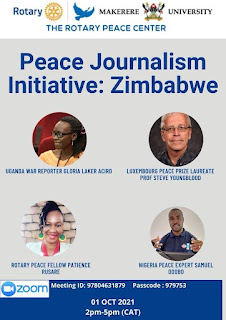Kansas City Star project reflects the best of peace journalism
The truth can be painful. Just ask the Kansas City Star’s
Mara Rose Williams, who “many times sat at my desk and cried because I knew
these things happened. It made me so sad that I just cried.”
 |
| Mara Rose Williams |
“These things” are a century of neglect of and racism
directed at Kansas City’s African American community by the
Kansas City Star newspaper. In
2020, Williams decided that the newspaper needed to expose "these things." She developed, pitched, and led a project at the
Star called “
The Truth in Black and White” that offered
an examination of and apology for the
Star’s mistreatment of
African Americans.
This project is exemplary, textbook peace journalism.
Williams’ presentation, part of the Greater Kansas City
Peacebuilding Conference, was given yesterday at Park University. The event,
co-sponsored by Park’s Center for Global Peace Journalism and Johnson County
Community College, was held both in person and on Zoom.
“The Truth in Black and White” analyzed the paper’s
coverage of crime, education, civil rights, the 1977 flood, education, redlining, and
culture. “It wasn’t enough to write an apology,” Williams said, “(so we) put
together a team to research past stories and re-write them they way they
should’ve been written in the first place.”
For example, in analyzing the Star's coverage of the civil
rights movement, her team found that protests were framed by the paper as
riots. Protesters, she said, were framed negatively, and when nothing
substantive was found to smear individuals, some tiny negative tidbit was
mentioned. For example, it was noted in the Star that a 16-year old black
protester had bad grades, or that another black civil rights protester was
divorced.
Many other times, African Americans and their
achievements and struggles were simply ignored by the Star.
The goal of the project was pure peace journalism—to give
a voice to the voiceless, to “transform the way the Kansas City Star attacks
journalism, and deals with and writes about its marginalized communities going
forward.” Williams believes “The Truth in Black and White” is doing just
that—"changing the Star’s DNA.” In response to the project, the paper has
formed an advisory committee and hired a race and equity editor, and has begun
running African American obituaries.
Another peace journalism element embraced by the project
is to “build bridges and break down silos,” according to Williams. “If a
newspaper can polarize, it can also unite,” she observed.
Williams told the audience she considers herself a peace
journalist. She is not alone in this assessment. Her groundbreaking work
provides a blueprint for media of all kinds to reach out to marginalized
communities, to give a voice to these marginalized voiceless, to build bridges
between seemingly disparate communities, and to give agency to these voices as
solutions to societal problems are discussed and decided.
“I wanted to be a part of peace journalism, as a
journalist who perpetuated peace,” Williams said. “It’s why I got into this
business. I’m happy to be a peace journalist.”
Yesterday’s session at Park was moderated by journalist
and educator Lewis Diuguid. The third and final session of the peacebuilding
conference is Wednesday, Oct. 27. For more details and to register for free,
see https://www.jccc.edu/conferences/peacebuilding/.





